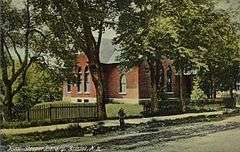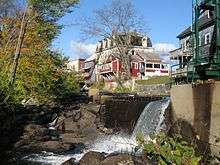Bristol, New Hampshire
| Bristol, New Hampshire | ||
|---|---|---|
| Town | ||
|
Central Square in 2012 | ||
| ||
| Motto: "The Gateway to Newfound Lake" | ||
 Location in Grafton County, New Hampshire | ||
| Coordinates: 43°35′28″N 71°44′12″W / 43.59111°N 71.73667°WCoordinates: 43°35′28″N 71°44′12″W / 43.59111°N 71.73667°W | ||
| Country | United States | |
| State | New Hampshire | |
| County | Grafton | |
| Incorporated | 1819 | |
| Government | ||
| • Board of Selectmen |
Shaun Lagueux Rick Alpers JP Morrison Paul Manganiello Leslie Dion | |
| • Town Administrator | Nik Coates | |
| Area | ||
| • Total | 22.4 sq mi (57.9 km2) | |
| • Land | 17.1 sq mi (44.3 km2) | |
| • Water | 5.3 sq mi (13.6 km2) 23.43% | |
| Elevation | 466 ft (142 m) | |
| Population (2010) | ||
| • Total | 3,054 | |
| • Density | 140/sq mi (53/km2) | |
| Time zone | Eastern (UTC-5) | |
| • Summer (DST) | Eastern (UTC-4) | |
| ZIP code | 03222 | |
| Area code(s) | 603 | |
| FIPS code | 33-07700 | |
| GNIS feature ID | 0873552 | |
| Website |
www | |
Bristol is a town in Grafton County, New Hampshire, United States. The population was 3,054 at the 2010 census.[1] It is home to Wellington State Park, Sugar Hill State Forest, and Profile Falls on the Smith River. Surrounded by hills and lakes, Bristol includes the lower two-thirds of Newfound Lake, a resort area.
The primary settlement in town, where 1,688 people resided at the 2010 census,[1] is defined by the U.S. Census Bureau as the Bristol census-designated place (CDP) and is located at the intersection of New Hampshire routes 3A and 104.
History
Bristol was taken from Bridgewater and New Chester (now Hill) and incorporated 24 June 1819. Colonel Peter Sleeper, Benjamin Emmons and others commenced a settlement here in 1770.[2]
Extensive deposits of fine sand or clay similar to the "Bristol sand" used in Bristol, England, to make fine china and pottery gave the town its name. Here the sand was used to make a superior quality brick, marketed as Bristol brick. With water power from the Pemigewasset River, the town was a center of manufacturing in the early days for goods such as paper, leather, woolens, flannel, bedsteads and piano stools.[3]
On January 16, 1884, the town of Bristol voted to accept the gift of a library building and land from Josiah Minot and Solomon Sleeper and to manage and maintain a public library. The Minot-Sleeper Library became the first building erected to specifically house a public library in the Lakes Region at the time, when it was officially opened to the community in 1885.On August 15, 2012 a groundbreaking ceremony was held in celebration of the library's expansion. In February 2013, the new addition was ready for use.
Bristol is one of four towns with shoreline on Newfound Lake, which has been a tourist destination since the mid-19th century. Farmers at first rented rooms and provided meals, but in the 1870s, hotels including the Hotel Bristol and G. G. Brown Hotel were built. In 1874, Bristol was the terminus of the Franklin and Bristol Branch railroad. The New Hampshire Central Railroad was planned to pass through Bristol.[2] In the 1920s, W. F. Darling created a compound of about one hundred cottages for rent, first known as Hiland Park and later as Bungalo Village. In 2004, the compound was sold to a proprietor who sold individual cottages to permanent owners.
-

The Hotel Bristol in 1911
-

Central Square in 1906
-

The Ledges in 1912
-

Minot-Sleeper Library c. 1910
Geography
.jpg)
According to the United States Census Bureau, the town has a total area of 22.4 square miles (58.0 km2), of which 17.1 square miles (44.3 km2) is land and 5.3 square miles (13.7 km2) is water, comprising 23.43% of the town.[4] Bristol is drained by the Pemigewasset River (forming the southeastern boundary of the town), the Smith River (on the town's short southern boundary) and the Newfound River, draining Newfound Lake and most of the center of town. The highest point in town is Bristol Peak, elevation 1,803 feet (550 m) above sea level. Bristol lies fully within the Merrimack River watershed.[5]
The town center, defined as a census-designated place (CDP), covers an area of 4.8 square miles (12 km2), about 21.5% of the area of the town.
Bristol is served by state routes 3A and 104.
Demographics
| Historical population | |||
|---|---|---|---|
| Census | Pop. | %± | |
| 1820 | 675 | — | |
| 1830 | 799 | 18.4% | |
| 1840 | 1,153 | 44.3% | |
| 1850 | 1,103 | −4.3% | |
| 1860 | 1,124 | 1.9% | |
| 1870 | 1,416 | 26.0% | |
| 1880 | 1,352 | −4.5% | |
| 1890 | 1,524 | 12.7% | |
| 1900 | 1,600 | 5.0% | |
| 1910 | 1,478 | −7.6% | |
| 1920 | 1,428 | −3.4% | |
| 1930 | 1,610 | 12.7% | |
| 1940 | 1,632 | 1.4% | |
| 1950 | 1,586 | −2.8% | |
| 1960 | 1,470 | −7.3% | |
| 1970 | 1,670 | 13.6% | |
| 1980 | 2,198 | 31.6% | |
| 1990 | 2,537 | 15.4% | |
| 2000 | 3,033 | 19.6% | |
| 2010 | 3,054 | 0.7% | |
| Est. 2015 | 3,073 | [6] | 0.6% |
As of the census of 2000, there were 3,033 people, 1,219 households, and 830 families residing in the town. The population density was 174.9 people per square mile (67.5/km²). There were 2,073 housing units at an average density of 46.2 persons/km² (119.5 persons/sq mi). The racial makeup of the town was 96.08% White, 0.26% African American, 0.40% Native American, 1.38% Asian, 0.03% Pacific Islander, 0.49% from other races, and 1.35% from two or more races. 0.96% of the population were Hispanic or Latino of any race.
There were 1,219 households out of which 31.3% had children under the age of 18 living with them, 53.3% were married couples living together, 11.0% have a woman whose husband does not live with her, and 31.9% were non-families. 24.8% of all households were made up of individuals and 9.1% had someone living alone who was 65 years of age or older. The average household size was 2.47 and the average family size was 2.94.
In the town the population was spread out with 24.3% under the age of 18, 7.0% from 18 to 24, 29.9% from 25 to 44, 24.6% from 45 to 64, and 14.2% who were 65 years of age or older. The median age was 38 years. For every 100 females there were 97.3 males. For every 100 females age 18 and over, there were 91.5 males.
The median income for a household in the town was $38,032, and the median income for a family was $44,766. Males had a median income of $31,088 versus $22,406 for females. The per capita income for the town was $19,807. 6.9% of the population and 5.5% of families were below the poverty line. Out of the total people living in poverty, 7.6% are under the age of 18 and 8.4% are 65 or older.
Town center

As of the census of 2000, there were 1,670 people, 692 households, and 458 families residing in the CDP (census-designated place) occupying the town center. The population density was 352.1 people per square mile (136.0/km²). There were 928 housing units at an average density of 75.6 persons/km² (195.7 persons/sq mi). The racial makeup of the town was 96.53% White, 0.06% African American, 0.42% Native American, 1.20% Asian, 0.00% Pacific Islander, 0.06% from other races, and 1.74% from two or more races. 1.14% of the population were Hispanic or Latino of any race.
There were 692 households out of which 31.9% had children under the age of 18 living with them, 48.1% were married couples living together, 14.2% have a woman whose husband does not live with her, and 33.8% were non-families. 28.3% of all households were made up of individuals and 12.0% had someone living alone who was 65 years of age or older. The average household size was 2.39 and the average family size was 2.90.
In the CDP the population was spread out with 24.8% under the age of 18, 8.3% from 18 to 24, 29.2% from 25 to 44, 22.8% from 45 to 64, and 15.0% who were 65 years of age or older. The median age was 38 years. For every 100 females there were 94.9 males. For every 100 females age 18 and over, there were 88.0 males.
The median income for a household is $32,992, and the median income for a family was $40,804. Males had a median income of $30,478 versus $21,741 for females. The per capita income for the town was $20,011. 9.8% of the population and 7.7% of families were below the poverty line. Out of the total people living in poverty, 10.6% are under the age of 18 and 14.0% are 65 or older.
Notable people
- Luther Atwood, an American chemist in the oil industry
- Nathaniel S. Berry, 28th governor of New Hampshire
- John Cheever, writer (summer resident)
- Benjamin Flanders, Reconstruction Governor of Louisiana; mayor of New Orleans
- Lenny McNab, Food Network chef (born and raised)
- Fred Lewis Pattee, writer and professor of American literature (born and raised)[8]
- Thomas A. Watson, inventor (summer resident)
References
- 1 2 United States Census Bureau, American FactFinder, 2010 Census figures. Retrieved March 23, 2011.
- 1 2 Article in Statistics and Gazetteer of New-Hampshire (1875)
- ↑ Coolidge, Austin J.; John B. Mansfield (1859). A History and Description of New England. Boston, Massachusetts. pp. 429–430.
- ↑ "Geographic Identifiers: 2010 Demographic Profile Data (G001) - Bristol town, New Hampshire". U.S. Census Bureau American Factfinder. Archived from the original on September 11, 2013. Retrieved November 10, 2011.
- ↑ Foster, Debra H.; Batorfalvy, Tatianna N.; Medalie, Laura (1995). Water Use in New Hampshire: An Activities Guide for Teachers. U.S. Department of the Interior and U.S. Geological Survey.
- ↑ "Annual Estimates of the Resident Population for Incorporated Places: April 1, 2010 to July 1, 2015". Retrieved July 2, 2016.
- ↑ "Census of Population and Housing". Census.gov. Archived from the original on May 11, 2015. Retrieved June 4, 2016.
- ↑ "Pattee, Fred Lewis". Penn State Libraries. Pennsylvania State University. Retrieved 3 May 2015.
External links
- Town of Bristol official website
- Bristol Historical Society
- Minot-Sleeper Library
- Pemigewasset Valley Snowmobile Club
- A Walking Tour of Historic Bristol, New Hampshire
- Wellington State Park
- New Hampshire Economic and Labor Market Information Bureau Profile


